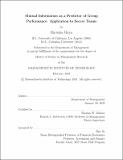Mutual Information as a Predictor of Group Performance: Application to Soccer Teams
Author(s)
Miura, Hirotaka
DownloadThesis PDF (748.2Kb)
Advisor
Malone, Thomas W.
Terms of use
Metadata
Show full item recordAbstract
Predictors of group performance based on observational data about interactions among group members could be useful for many organizations. However, existing methods to formulate such predictors tend to be complicated or miss key relationships in the data. We demonstrate that a simple measure derived from information theory called mutual information is predictive of group performance. Mutual information captures the probabilistic dependency between two states, and can incorporate the time dimension to quantify dynamic interactions. Here we apply mutual information to analyze the pattern of passing between members of 11-player soccer teams in approximately 2,000 matches. We employ a modern econometric technique called debiased machine learning to estimate predictive effects of mutual information on game outcomes, controlling for many features including player-level events taking place on the field as well as opponent actions. Holding all other variables constant, we find a 0.01 unit increase in mutual information, roughly equivalent to moving a team from the bottom of the metric to the average, is associated with approximately a 4% increase in the likelihood of winning a game and 0.07 more goals during a game. As a comparison, all else equal, homes games are associated with about 0.26 more goals, implying that the effect size of mutual information on number of goals is equal to about a quarter of the effect size observed for home games. Stratifying by time, we find that around 50% of the effect of mutual information on number of goals for the entire match is observed during the middle of the game, suggesting that mutual information could be a leading indicator of group performance. These effects are separate from the impact of number of passes, which we find has a net zero effect on wins, losses, and draws, and a negative effect on number of goals. Together, these results suggest that mutual information could provide a simple way of predicting group performance using observational data.
Date issued
2023-02Department
Sloan School of ManagementPublisher
Massachusetts Institute of Technology